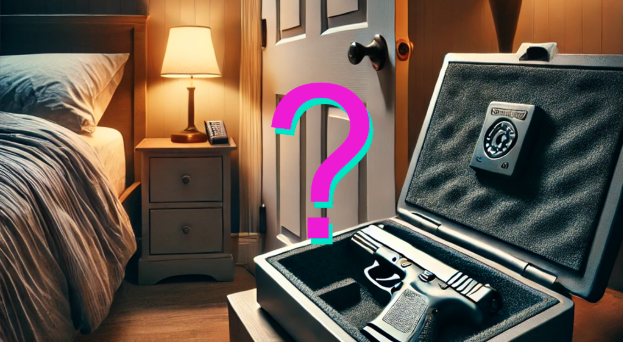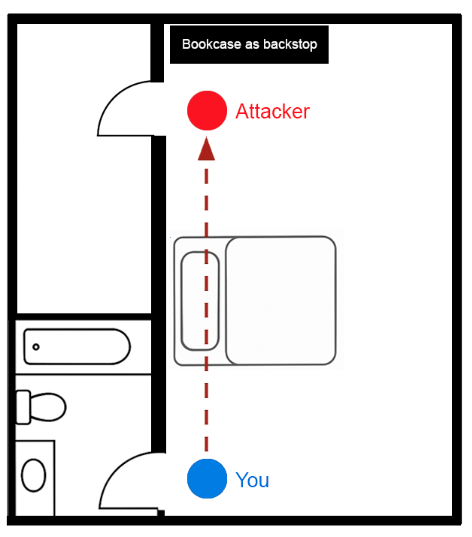Which gun do I buy for home defense?
This post focuses on choosing the right firearm focused on home and community defense from the specific perspective of a new gun owner looking for the most efficient way to get started.

This post is part of our ongoing blog series designed to help individuals make informed decisions about firearm ownership and selection. If you are still considering whether gun ownership is right for you, we recommend reading our article, Should You Buy a Gun?, which covers the responsibilities, risks, and considerations of gun ownership before making a purchase. Then make sure to read What Type of Gun Should I Buy? which introduces the primary armed defense use cases and presents an argument that for most people, starting with a handgun offers clear advantages.
In this post, we focus on selecting a firearm that best meets the demands of home defense and community defense scenarios.
- Home defense refers to defending yourself and your loved ones within your residence, whether that be a house, apartment, or other dwelling. This scenario typically involves short engagement distances, maneuverability concerns, and the need for quick access to a secure firearm.
- Community defense extends beyond your home to defending your neighborhood, rural property, or a larger community space in the event of civil unrest, natural disasters, or other emergencies. This can involve longer engagement distances, increased capacity considerations, and the need for coordinated defense efforts.
Much exists out there about home defense options and most of what you’ll find approaches this question from the perspective of which gun is the best for home defense, as if there is a single gun that is the best choice for everyone in every situation. We’ll explore a different approach specifically through the lens of the new gun owner looking for the most efficient way to get started with armed home defense to help you make the best choice for your specific situation.
Legal Constraints
Before selecting a firearm, consider the legal limitations in your area. Some states impose restrictions on rifle ownership, AR-15-style firearms, magazine capacities, or storage requirements that could impact how you stage a home defense weapon. Additionally, consider how self-defense cases are perceived in your jurisdiction—while legally justified, certain firearms may be viewed less favorably by a jury, potentially influencing legal outcomes.
Expected Engagement Distance
The size of the property or area you plan to defend plays a key role in firearm selection. In smaller homes or apartments, engagement distances are short, making nearly any firearm effective. Larger homes, rural properties, or community defense scenarios may require accuracy beyond 25 yards. Rifles excel at longer distances, while shotguns and handguns are best suited for close-quarters engagements.
Over-Penetration Risks
A major concern in armed defense is what happens if you miss your target. Bullets that pass through walls can injure unintended targets, making this a critical factor in urban or multi-family housing.
Selecting the right ammunition helps mitigate over-penetration risks. Shotguns loaded with defensive rounds like Federal Flight Control or Hornady Critical Defense maintain tight shot patterns while reducing excessive penetration. Hollow point ammunition for handguns also limits penetration. Surprisingly, 5.56/.223 rifle rounds often fragment sooner than one would expect upon impact with walls, making them potentially better than handgun calibers for overpenetration risk mitigation.
Of course, ammunition risks can vary greatly depending on wall materials and if projectiles hit studs, pipes, or other solid objects in your walls. With that in mind, ammunition choice is only one part of the equation, and perhaps it's not the most important factor. The reality is that nearly all common defensive ammunition—regardless of caliber or firearm type—can and will penetrate interior walls constructed from drywall and wood framing. Even the most fragmentation-prone rounds are still capable of traveling through multiple rooms or striking unintended targets if no solid barrier is present.
The most effective way to mitigate over-penetration risk is planning your likely shot paths in advance. Defensive planning should include identifying the areas in your home where an armed encounter is most likely, determining where you would stand, and reinforcing what is behind the space an intruder would occupy.
For example, if your bedroom is your designated fallback position, you can arrange your furniture so that you have a solid shooting angle 90 degrees to the door, ideally positioning yourself so that the intruder enters into a narrow fatal funnel. Behind the expected line of fire, placing heavy furniture such as a solid bookshelf filled with books, a dresser full of clothes, or even a flipped-up mattress can act as an improvised backstop to help stop any missed rounds.
Example Floor Plan
In this diagram, the defender stands at a 90-degree angle from the door, using the corner of the room as cover. The attacker entering through the door is immediately in the defender’s line of sight. Behind the attacker’s likely position is a thick, reinforced bookcase acting as a ballistic backstop.
By taking proactive steps like this, you dramatically reduce the chance of injuring others in your home or neighboring units—even more than simply choosing the “right” ammo. Environmental preparation and responsible staging should always be part of your home defense planning.

Who Will Use the Firearm?
If multiple people in your household may need access to the firearm, consider their ability to handle recoil and operate it under stress. A 12-gauge shotgun can be difficult to control for smaller individuals or those with limited strength. Rifles in 5.56/.223 offer low recoil and ease of aiming but may be unwieldy for those unfamiliar with their operation. Handguns are the easiest to store and handle but require significant training to shoot accurately under stress.
Storage and Accessibility
Balancing security and accessibility is essential. Firearms should be secured from unauthorized users while remaining quickly accessible in an emergency.
- Handguns: Easy to store in small safes or biometric lockboxes, offering a good balance between security and readiness.
- Shotguns/Rifles: Require larger safes or purpose-built furniture for storage but can be staged effectively with proper planning.
If children, landlords, maintenance personnel, or guests have access to your home, secure storage is especially critical.
Maneuverability in the Home
A key factor in home defense is your ability to move within tight spaces. Long guns (rifles and shotguns) can be cumbersome in hallways and doorways. If your defense plan involves staying in a barricaded position, maneuverability is less of a concern. However, if you may need to move through your home to protect family members, a more compact firearm—such as a handgun or short-barreled rifle—may be preferable.
Hands-Free Use
Defensive situations often require multitasking—calling 911, carrying children, or opening doors while keeping your firearm accessible. Rifles and shotguns equipped with slings allow for hands-free use, making them advantageous in these scenarios. Handguns require a holster, which may not be practical depending on attire, though a staged velcro belt with a holster for your handgun with a spare magazine (known as a "battle belt") can provide a quick-access solution.
Training Availability
Owning a firearm is only part of the equation—developing the skills to use it under stress is critical. Unfortunately though, not all training is created equal. Many courses, including those required for permits, focus on general firearm knowledge, hunting, or competition shooting rather than practical self-defense.
Proper defensive shooting training focuses on the real world scenarios likely to be faced by civilians, not military or competition style scenarios that may be fun, but ultimately do not translate well to the most plausible scenarios. Your defensive shooting training should help you achieve viable levels of skill with the least amount of time, effort, and energy as possible, and should include a high degree of realism that integrates movement, randomizes scenarios, factors in the body's natural reactions to extreme stress, and addresses cognitive processing while under stress.
- Defensive Handgun Training: The most widely available due to concealed carry courses and general defensive shooting classes.
- Defensive Rifle Training: Growing in popularity but may be restricted in some states or focused more on military tactics rather than home defense.
- Defensive Shotgun Training: Less common but some rifle training classes may also apply to defensive shotgun use.
Cost Considerations
The cost of a home defense firearm includes more than just the price tag on the gun itself. Ammunition, storage solutions, and ongoing training are essential components that add to the total investment.
- Handguns: A popular striker-fired semi-automatic pistol typically costs around $500. 9mm ammunition runs about $0.25 per round. Handguns benefit from affordable and compact storage options and widely available training classes.
- Rifles: A quality semi-automatic rifle may cost between $1000 and $2,000. .223/5.56 ammunition costs roughly $0.60 per round. Rifles require more expensive and space-consuming storage solutions and specialized training.
- Shotguns: A defensive shotgun typically costs around $800. Defensive-grade 00 buckshot ammunition can cost about $1 per round. Training options for defensive shotgun use are more limited.
While handguns are the most cost-effective option overall, rifles and shotguns offer advantages in power and range—at the expense of higher costs and training needs.
Effectiveness of Different Firearms
The concept of "stopping power" is often misunderstood. No firearm guarantees immediate incapacitation. Effectiveness is determined by a combination of shot placement, penetration, and the ability to deliver rapid follow-up shots.
- Handguns: Portable and easy to store, but hardest to shoot accurately under stress. They generally require more shots to neutralize a threat.
- Rifles: Offer higher velocity and better penetration with lower recoil than shotguns, making follow-up shots easier and more accurate.
- Shotguns: Provide immediate threat-neutralizing capability, but have significant recoil, limited capacity, and slower reload speeds.
Deterrence Factor
A common myth suggests that racking a shotgun or the appearance of an AR-15 will scare off intruders. Once an intruder is inside your home, relying on a firearm's appearance or sound as a deterrent is not a viable defense strategy.
Conclusion
Selecting the right home defense firearm depends on your unique needs, legal considerations, home layout, budget, training level, and more.
For most new gun owners, we recommend:
- Purchase and train for home defense with a handgun. They are inexpensive, easy to store, and skills transfer to concealed carry.
- If protecting larger spaces, consider also purchasing and training with semi-automatic rifles.
- If focused strictly on barricade or breaching scenarios, you could consider a shotgun. Otherwise, shotguns are our last choice for new gun owners.
Regardless of your choice, training and preparation are just as important as the firearm itself. To gain a deeper understanding, we recommend taking PDT’s Home and Community Defense Fundamentals class.